
Babiana is a genus of geophytes in the family Iridaceae with 93 recognized species as of March 2022. The leaves consist of a stalk and a blade that are at an angle to each other. The leaf blades are entire, laterally flattened and pleated, and often hairy. Each individual flower is subtended by two hairy or smooth bracts that are green in most species. The outer bract is often the largest of the two. In most species the bracts have a dry, brown tip, but in a few species it is entirely green or entirely dry when flowering or the outer bract is translucent and has a papery texture. The inner bract is forked or split all the way to its base. Each flower is without a pedicel, with six tepals that are merged at their base into a tube and form a perianth that is mirror-symmetrical in most species, with three anthers implanted where the perianth tube widens and that are, in almost every species, clustered at one side of the style. The style has three branches that widen towards the tip and the ovary is inferior. Flowers occur in almost every conceivable colour, many have markings on some of the tepals, and few star-symmetrical flowers have a centre that strongly contrasts with the free part of the perianth. The majority of these species are endemic to the west and southwest of South Africa, and southwestern Namibia, but one species occurs elsewhere in Namibia and South Africa and another species can be found in Botswana, Namibia, South Africa, Zambia and Zimbabwe. The genus name is derived from the Dutch word baviaan, referring to the Chacma baboon, Papio ursinus, that consumes the corms of plants in the genus. The genus is called bobbejaantjie in Afrikaans, meaning small baboon.
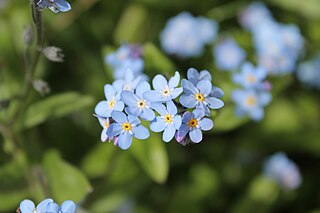
Myosotis sylvatica, the wood forget-me-not or woodland forget-me-not, is a species of flowering plant in the family Boraginaceae, native to Europe. This spring-flowering plant and its cultivars, typically with blue flowers, are the familiar forget-me-nots of gardens.
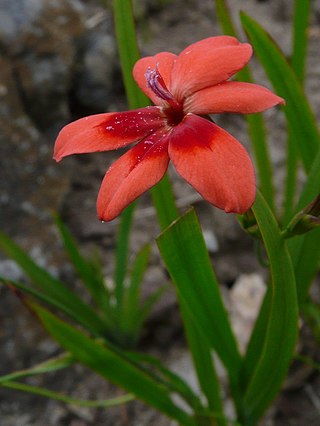
Freesia laxa, commonly known as flowering grass, is a small species of cormous flowering plant in the family Iridaceae, from eastern and southern Africa, from Kenya to northeastern South Africa. It is grown in gardens as an ornamental plant.

Iris foetidissima, the stinking iris, gladdon, Gladwin iris, roast-beef plant, or stinking gladwin, is a species of flowering plant in the family Iridaceae, found in open woodland, hedgebanks and on sea-cliffs.

Cyclamen hederifolium, the ivy-leaved cyclamen or sowbread, is a species of flowering plant in the family Primulaceae. This widespread cyclamen species is widely cultivated and among the most hardy and vigorous in oceanic climates. It is native to woodland, shrubland, and rocky areas in the Mediterranean region from southern France to western Turkey and on Mediterranean islands, and naturalized farther north in Europe and in the Pacific Northwest.
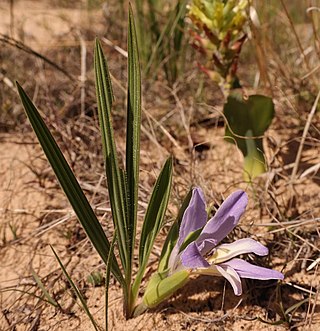
Babiana nana is a species of geophyte of 6–15 cm (2.4–5.9 in) high that is assigned to the family Iridaceae. It has leaves that consist of a sheath and a blade that are at an angle with each other. The leaf blades are oval to almost line-shaped and have a left and right surface, rather than an upper and lower surface. The leaf blades are moderately pleated and covered in dense, soft hairs. The inflorescence contains two to six blue to violet or pale pink flowers adorned with white markings on the lower lip, and with three stamens crowding under the upper lip. Flowering occurs from late August to the end of September. The flowers emit a smell reminiscent of roses or violets.

Crocus angustifolius, the cloth-of-gold crocus, is a species of flowering plant in the genus Crocus of the family Iridaceae, native to southern Ukraine and Armenia. It is a cormous perennial growing to 5 cm (2.0 in) tall and wide. The narrow grass-like leaves with silver central stripe appear in late winter or early spring. They are followed by bright yellow fragrant flowers with maroon blotches on the outer petals.
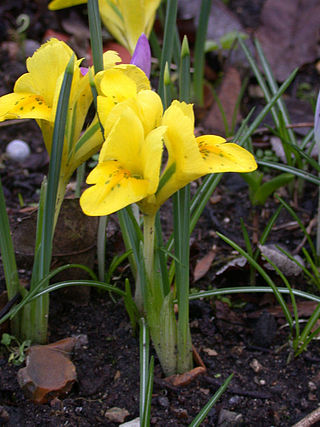
Iris danfordiae, the dwarf iris or Danford iris, is a bulbous perennial plant in the genus Iris, it is classified in the subgenus Hermodactyloides and section Reticulatae. It is from Turkey in Asia. It has 2 gray-green or bluish green, thick leaves, short slender stem holding a scented flower, in shades of yellow. They are spotted olive-green or green and have a deep yellow or orange crest.

Iris planifolia is a species of flowering plant in the subgenus Scorpiris of the genus Iris, family Iridaceae. This bulbous perennial from Southern Europe and North Africa has long, shiny green leaves, a short stem, and large scented flowers in various shades of blue.
Iris warleyensis is a species in the genus Iris, it is also in the subgenus Scorpiris. It is a bulbous perennial from Central Asia, Tajikistan, Turkmenistan and Uzbekistan. It has long arching mid-green leaves, thin stem and spring flowers in shades of blue.

Iris typhifolia is a species in the genus Iris, also the subgenus Limniris and in the series Sibiricae. It is a rhizomatous herbaceous perennial, from China. It has slender, twisted leaves, deep green slender hollow stem and 2 violet-blue flowers. It is cultivated as an ornamental plant in temperate regions.
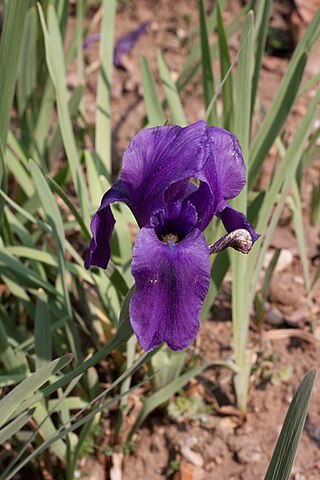
Iris hoogiana is a plant species in the genus Iris, it is also in the subgenus Iris and in the section Regelia. It is a rhizomatous perennial, from the grassy mountainsides of Turkestan. It has long green leaves, which are slightly purple at the base, and a long slender flowering stem. The flowers are blue, ranging from sky-blue to lavender blue and blue purple. It has orange or yellow beards. It is cultivated as an ornamental plant in temperate regions.

Babiana vanzijliae is a species of geophyte of 4–12 cm (1.6–4.7 in) high that is assigned to the family Iridaceae. It has leaves that consist of a sheath and a blade that are at an angle with each other. The leaf blades are narrow, sword- to lance-shaped and have a left and right surface, rather than an upper and lower surface. The leaf blades are pleated and covered in velvety hairs. The inflorescence contains three to five pale bluish mauve to yellow flowers, but the lower lateral tepals are yellow becoming pale around the edges, and with three stamens crowding under the upper lip. Flowering occurs from early August to the middle of September. The flowers emit a strong scent. B. vanzijliae grows along the Bokkeveld Escarpment near Nieuwoudtville in the Northern Cape province of South Africa.

Babiana bainesii is a species of geophyte of 15–25 cm (5.9–9.8 in) high that is assigned to the family Iridaceae. It sometimes grows in tufts. The approximately upright leaf blades appear directly from the ground, are narrow, sword- to line-shaped and have a left and right surface, rather than an upper and lower surface, and far exceed the flowers in length. The leaf blades are pleated. The inflorescence stem is fully underground and often branched. It contains two to eight blue, violet or mauve mirror-symmetrical flowers comprising six tepals. B. bainesii has a wide distribution and occurs in Botswana, Namibia, South Africa, southernmost Zambia and Zimbabwe.

Babiana villosa is a species of geophyte of 10–20 cm (3.9–7.9 in) high that is assigned to the family Iridaceae. It has mauve-pink, purple or scarlet star-symmetrical wide chalice-shaped flowers with narrow tube, large, blackish or dark purple anthers, and velvety hairy, lance-shaped, laterally compressed leaves, set in a fan. Flowers occur during August and September. It grows between Malmesbury and Wellington in the Western Cape province of South Africa. It is commonly called red babiana in English and rooibobbejaantjie in Afrikaans.

Babiana hirsuta is a species of geophyte of 40–70 cm (16–28 in) high that is assigned to the family Iridaceae. It has many scarlet mirror-symmetrical flowers in a branched inflorescence with several short ascending branches. The flower has a narrow tube, and three large, blackish or dark purple anthers that extend beyond the dorsal tepal. The leaves are velvety hairy, lance-shaped, laterally compressed and set in a fan. It is an endemic species of South Africa that can be found along the west coast of the Northern and Western Cape provinces as far south as Saldanha. It is called red babiana in English, but that name is also applied to Babiana villosa, and strandlelie, sandlelie and rooihanekam in Afrikaans. Until 2008, the strandlelie was known as Babiana thunbergii.

Babiana tubiflora is a species of geophyte of 7–15 cm (2.8–5.9 in) high that is assigned to the family Iridaceae. It has whitish mirror-symmetrical flowers with a long narrow tube that split into six tepal lobes, have three stamens, and line- to lance-shaped, laterally compressed leaves. It is an endemic species of South Africa that can be found along the west and south coast of the Western Cape province. It flowers from August to early October.

Babiana scabrifolia is a perennial plant of 5–15 cm (2.0–5.9 in) high that annually forms leaves and flowers from an underground corm and is assigned to the Iris family. It produces relatively large, pale lilac or blue flowers slightly above the soil, and soft, lightly pleated leaves that reach beyond the flowers. These leaves are lance-shaped to oblong in adults, but line-shaped and twisted in non-flowering specimens. Flowering occurs from June to August. The species can be found in the Western Cape province of South Africa.

Babiana hypogaea is a perennial plant of about 5–8 cm (2.0–3.1 in) high that annually forms leaves and flowers from an underground corm that is assigned to the iris family. It has pale greenish yellow, buff or rarely white, mirro-symmetrical flowers and line- to sickle-shaped, slightly pleated, thinly hairy or hairless leaves that are held horizontally or inclined, that grows in the summer rainfall areas of southeastern Namibia and central and northern central South Africa. Flowers may be found between June and September and sometimes between December and May. It is called Bobbejaankalkoentjie, Bobbejaanuintjie or Ertappeluintjie in Afrikaans.

Babiana mucronata is a perennial plant species that grows to about 5–18 cm (2.0–7.1 in) high and annually forms leaves and flowers from an underground corm. It is assigned to the iris family. It has a simple or branched, more or less upright spike of 3-12 dark to pale violet-blue, mirror-symmetrical flowers. Each flower consists of a perianth that is merged below into a funnel-shaped tube of 10–25 mm (0.39–0.98 in) long but splits into six unequal tepals. Three stamens are curved, crowded near the upper lip, and carry pale violet anthers. Flowers may be found between late July and September.



















